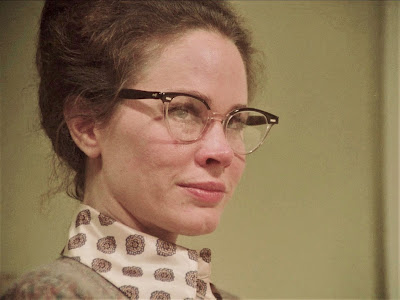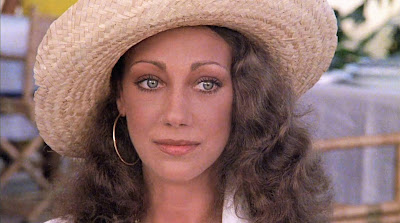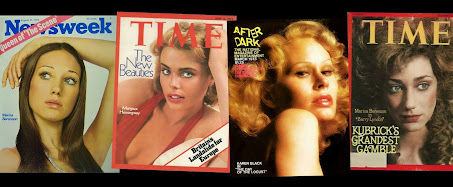Spoiler Alert: Crucial plot points are revealed in the interest of critical analysis and discussion
An unforeseen dividend in being a movie fan “of a certain age” is living long enough to see what films end up being the legacy benchmarks in the careers of actors I grew up watching. There’s something democratically perfect about the idea that no matter how accomplished, acclaimed, varied, or lengthy a career, no actor gets to decide what movie will "stick"...which film will be the movie they’ll most be remembered for.
It can be a film that kickstarts a career (flying in the face of the accepted dictum that this is just a taste of things to come, often it turns out to be their finest career hour--like Mia Farrow in (Rosemary’s Baby) and Liza Minnelli in (Cabaret). Or a movie of such nagging popularity that even a career's worth of an actor’s best efforts fails to diminish its influence--like Patty Duke in (Valley of the Dolls) and...Bless her heart...Faye Dunaway in (Mommie Dearest).
If internet saturation is any indicator, Breakfast at Tiffany’s has been branded as Audrey Hepburn’s official signature motion picture. Though one suspects it's a reputation built on the actor's stylish elegance, rather than anyone having actually watched the clumsy, problematic film.
Speaking of problematic, for years now I've thought that Jane Fonda's Barbarella would be the title she's most associated with (it certainly is for me), but for many, the comic book sci-fi spoof has simply not aged very well, making Fonda's Klute the likely immortality contender.
And when I think of Shelley Winters, my mind zips right past Lolita, A Patch of Blue, and The Diary of Anne Frank, only to land squarely on the deck of the S.S. Poseidon. Go figure.
Time becomes the great leveler. The public, the ultimate determiner of what film in an actor's resume has left the most indelible impression.
 |
| The Day of the Locust - 1975 |
No one symbolized the cinema of the 1970s for me quite like Karen Black. One of the more prolific and visible actresses of the decade, Black was a true original whose every virtue embodied the iconoclast spirit of Hollywood’s new wave of filmmakers (indeed, seeming to be everywhere at once and in every new movie that came out, she was like the Jack Carson of the New Hollywood).
I first saw Karen Black in Francis Ford Coppola's coming-of-age comedy You’re a Big Boy Now (1966) when it was shown on TV in 1969. I didn’t know her name then, but as the unglamorous “good girl” waiting on the sidelines for the hero to notice her (a type she was never cast as again), she radiated such a sweetness and oddball vulnerability that I was drawn to her character immediately. Later that same year, when I saw Dennis Hopper and Peter Fonda's Easy Rider (1969), so thoroughly had Black transformed herself from the soft-spoken love interest in Coppola's film, I didn't even recognize her (even after sitting through it twice) as the long-legged, scene-stealing New Orleans prostitute.
By 1970 the chameleonic character actress was being earmarked for major stardom after her breakout, Oscar-nominated, Golden Globe Award-winning supporting performance in Five Easy Pieces (1970). Between 1971 and 1978, Karen Black appeared in 18 feature films, and I tried to see as many as I possibly could. Karen Black had become my new favorite — a kind of Stateside Glenda Jackson when it came to glamour-free fearlessness and risk-taking — and I was certain there was no one else quite like her in the movies.
 |
| Five Easy Pieces - 1970 |
To me, Karen Black's particular gift was her emotional authenticity and talent for making her characters relatable. She made the arcane and artificial “establishment” standards of beauty that once defined what movie stars looked like seem obsolete. She always seemed to “be” who she was playing, and the lack of self-consciousness in her acting style had a way of granting even the most extreme characters a personal dignity.
Although Karen Black's tenure as a mainstream, A-list star was surprisingly brief (she didn’t get first billing in an American movie until 1976’s Family Plot, and by 1977 she was appearing in stuff like Killer Fish), but during that time she had the great good fortune to have appeared in what are currently recognized as some of the most iconic, influential, and enduring films of the decade: Easy Rider–1969, The Great Gatsby–1974, Airport 1975–1974, Nashville–1975, Family Plot–1976, Burnt Offerings–1976, and my personal favorite The Day of the Locust–1975.
When Karen Black died on August 8, 2013, the films obituaries singled out as her most memorable were: her vulnerable waitress in Five Easy Pieces, the pathetic Myrtle in The Great Gatsby, Nashville's country singer Connie White, and the plucky Nancy ("The stewardess is flying the plane?!") Pryor of Airport 1975. No argument from me.
But I'm sticking to my guns when I contend that when the respectability smoke clears and the prestige-impressed voices of the critics and cineastes die down, the first movie that comes to mind when the average person thinks of Karen Black is 1975s Trilogy of Terror...arguably the most widely-seen and most well-known of all of her films.
 |
| Woman Times Four |
In the ‘70s, the division between movie star and TV star was far more pronounced than it is today, so it was big doings in the Anderson household (my corner of it, anyway) that THE Karen Black was starring in a made-for-TV movie; a genre that, to my mind, had heretofore been the near-exclusive domain of Donna Mills, Kay Lenz, and William Windom. It was especially notable because career-wise, Karen Black was primarily a cult-popular actress who was just starting to make a mainstream name for herself.
Trilogy of Terror aired just a couple of months after Black was awarded the Best Supporting Actress Golden Globe for The Great Gatsby. In fact, both Gatsby and Airport 1975 were still playing in theaters when the TV-movie was broadcast. Adding further to the feeling that 1975 was The Year of Karen Black was the fact that all over town and everywhere you turned, you were confronted with ads, articles, and posters heralding Black's forthcoming summer releases—The Day of the Locust in May, Nashville in July.
 |
| Airport 1975 - 1974 |
Hotly anticipated by yours truly, Trilogy of Terror was broadcast on Tuesday, March 4, 1975, at 8:30 pm as one of the last entries in the final season of the immensely popular ABC Movie of the Week series that began in 1969. Directed and produced by Dan Curtis of Dark Shadows fame, the trio of terror tales making up this anthology are all based on short stories by Richard Matheson (Die! Die! My Darling! – 1965). William F. Nolan (screenwriter for that other Dan Curtis/Karen Black collaboration Burnt Offerings) wrote the teleplays for the first two, and Matheson himself adapted the iconic final episode.
TRILOGY OF TERROR
 |
| Based on the short story: The Likeness of Julie - 1962 |
The male gaze is given a (Karen) black eye in this first tale of “terror,” which casts Ms. Black as a buttoned-up, dressed-down English Lit teacher who finds herself the target of the abusive sexual attentions of a student (Robert Burton, then Mr. Karen Black).
 |
| Karen Black as Miss Julie Eldridge |
.jpg) |
| Robert Burton as Chad Foster |
JULIE is my second-favorite story in the trilogy, not least in part due to its singularly emphatic kink factor, and for its devilishly clever affiliating of the proprietorial dominance of the male gaze (a form of presumptive access to, and ownership of, the female body) with voyeurism, scopophilia, date rape, and sexual exploitation. A psychological thriller with a touch of the occult/ supernatural, JULIE is a fine work of feminist horror and made me think of Ira Levin’s Rosemary’s Baby and The Stepford Wives.
.jpg) |
| Hot for Teacher |
Of course, Levin’s contemporary gothics were at the forefront of my mind back in 1975 because the movie version of The Stepford Wives had opened in theaters just a month before Trilogy of Terror aired. In fact, the darkly satirical horror of The Stepford Wives…an ideal distillation of post-Women’s Lib male panic…felt in parallel with JULIE’s use of the micro-inequities of day-to-day male/female sexual politics as the springboard for a horror story centralizing what we now understand to be the hidden-in-plain-sight atmosphere of harassment and potential violence women are exposed to on college campuses (well, everywhere, honestly). A point emphasized in the opening sequence where self-styled campus Casanova Chad and his buddy Eddie (Jim Storm) voice their toxic opinions while engaged in the “harmless” act of girl-watching: Chad -“God, have you ever seen so many dogs in one place?”
With the villain early-identified and primary focus of the action being the intensifying degrees of Chad’s abuse, dramatic tension is largely of the pressure-cooker variety; Julie will either break or break free…but something’s got to give. And it does. Rather effectively, I must say, in a nifty twist ending I did NOT see coming at the time.
Though the most heavily populated of the three stories—affording an almost orgasmic parade of outré ‘70s fashions—JULIE is essentially a two-hander. Robert Burton makes for a convincing chauvinist sleazeball (coyly alluded to as being a natural talent by Karen Black on the DVD commentary, perhaps explaining why their 18-month marriage had already dissolved by the time the TV movie came out), but it’s Karen Black’s show all the way.
Black is always fascinating to watch and never less than believable in depicting Julia’s trauma. But it’s only after I saw the entire vignette and the twist was revealed that Black’s traditional, almost cliché characterization of an “academic” (precise diction, books clutched to the bosom, mainspring-tight hairdo, owlish spectacles, soft voice) struck me as being perhaps the “performative” display I think it’s intended to be. Until the very last scene, Julie is more or less “acting” the part of the meek bookworm.
By the way, double kudos to whoever’s idea it was for Julie to keep her spectacles on during the film’s big “reveal” scene.
.jpg) |
| The framing of the final sequence emphasizes Julie's physical dominance over Chad |
After decades of women whipping off their suddenly-useless glasses after letting their hair down, Julie exercising her power while wearing glasses (this is a woman who doesn’t care if men seldom make passes) is an almost Hitchcockian touch (apropos that director's well-known fondness for women in eyewear). Particularly in a story about the power of the gaze.
 |
| Based on the short story: Needle in the Heart - 1969 |
“There are just some people who’ll come to any [movie] with story overviews. It’s nothing to do with the acting or with the writing at all. It’s just that . . . they say, ‘well if the story’s going this way, a great ending would be this. And if a story’s going that way, the surprise would be that.’”
That’s Karen Black on the Trilogy of Terror commentary track explaining to teleplay writer William F. Nolan her insightful theory on why Millicent & Therese, the trilogy's second terror tale, is so often dismissed with the claim of being predictable. Black is correct in recognizing that when a viewer is presented with something as overworked as the “good twin-evil twin” trope in a horror movie, it takes no great feat of cleverness to guess that if there's going to be a twist ending, that twist will reveal the twins (who are never shown occupying the same frame) are the same person.
 |
| Karen Black as Millicent Larimore |
 |
| Karen Black as Therese Larimore |
But what made the whole thing seem new was the hinted-at cause of Millicent/Therese’s split personality. Behind the genre trappings of voodoo, witchcraft, and demonology is a poignant story of ongoing childhood sexual abuse and how the victim dealt with her trauma by slipping into a catastrophically extreme form of dissociation. A splintering off of her psyche to protect herself from dealing with what is happening (and, in the matter of the death of her mother, what she has done).
Significantly, it's the death of the father that precipitates the showdown between the two sisters. The child is at last "safe" but too many years of identity suppression has clouded the awareness of which personality was genuinely that of the child and which developed as a defense mechanism.
 |
| It's nice seeing Dark Shadows' John Karlen as Mr. Anmar, one of Therese's lovers |
But when it comes to acting, Karen Black transcends the obvious and gives two rather terrifically realized, distinctly separate performances. Veering effortlessly between compelling and camp, Black gives what amounts to a “best of” performance medley of the quirks, idiosyncrasies, and unique talents that made her one of the most intoxicatingly watchable actresses of her time.
Copyright © Ken Anderson 2009 - 2022
 |
| Based on the short story: Prey - 1968 |
A woman spends a nightmarish evening fighting for her life after inadvertently releasing the spirit of a Zuni warrior encased in an ancient fetish doll.
When the topic turns to Trilogy of Terror, the now-iconic AMELIA episode is what everyone thinks of exclusively. And for good reason. Even after all these years, the idea of an ankle-high, razor-toothed, knife-wielding Zuni warrior speeding at you across the wall-to-wall carpet is still pretty hair-raising shit. Coupled with Karen Black’s glass-shattering screams, frequent falls, and oh-so-relatable shock reactions, there can be no mystery as to why this memorable horror vignette has achieved the status of kindertrauma classic.
 |
| Karen Black as Amelia |
I was a senior in high school when Trilogy of Terror aired, so while the widely-watched TV movie was all any of us could talk about at school the following day, it was never the stuff of nightmares as it was for so many who have claimed it as their seminal childhood freakout.
(Curiously enough, my own kindertrauma moment was a different teleplay written by Trilogy of Terror’s Richard Matheson. It was that 1961 episode of The Twilight Zone titled “The Invaders.” It starred Agnes Moorehead as a woman alone in a deserted farmhouse terrorized by ankle-high, knife-wielding spacemen.)
Karen Black’s performance in this episode is the jewel in the trilogy’s crown. It’s a one-woman show-stopper (she should have been Emmy-nominated for the self-penned phone monologue sequence alone) that sees Black’s wholesale commitment to her character and Matheson’s fantastic premise saving the whole thing from slipping into macabre silliness.
Playing on primal fears and familiar phobias, AMELIA is a “fun” scare all the way, allowing the viewer to jump in surprise, squirm at the suspense, giggle at their own jitters, and yell at the screen “Don’t open that suitcase!” Best of all, Amelia is a character we really root for. So much so that the film’s literal killer ending is hard not to be perceived as a triumph for Amelia, for she is at last in a position (a warrior’s crouch, in fact) to have the last word with her mother.
 |
| Burnt Offerings - 1976 |
Although it’s well-known that Trilogy of Terror was a movie that Karen Black initially had no interest in making, and that she perhaps ultimately regretted the film’s popularity, contributing to her becoming pigeonholed as a horror "Scream Queen" and taking her career in a direction she hadn't intended. But as a Karen Black fan who has always been a little bit frustrated by how little camera time she has in some of her most famous supporting roles, I’m grateful as hell for Trilogy of Terror. Not just because it represents some of her best work, but because it's a stellar, front-and-center showcase for a brilliant actress who too often had to shine from the sidelines.
Scene from "Trilogy of Terror" 1975
.jpg) |
| Sweet Dreams |



.jpg)


.jpg)


























